Winter Steelhead Fishing Pennsylvania
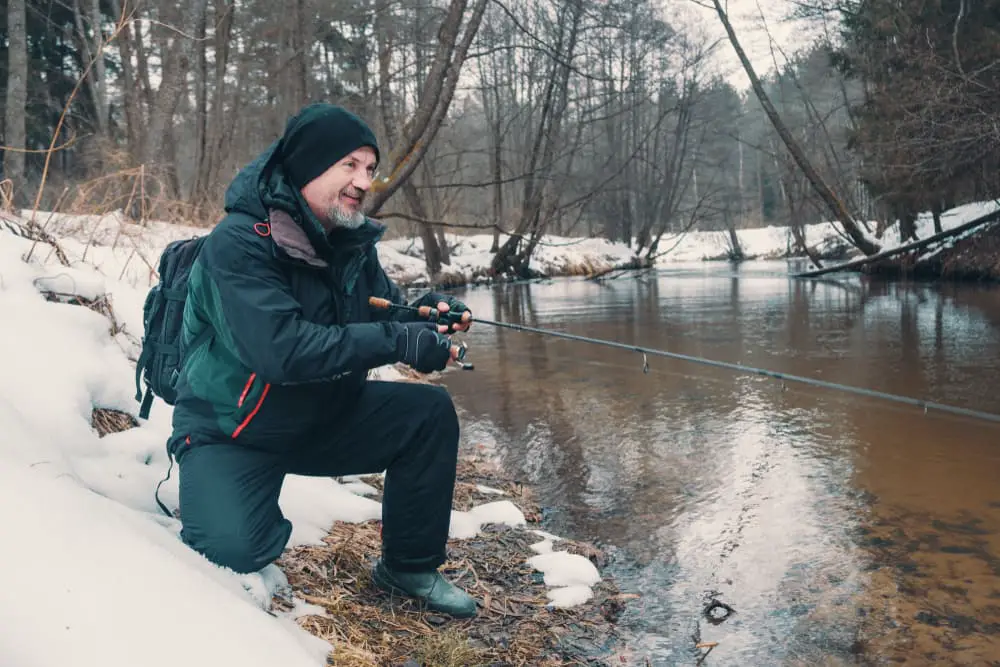
Many local PA fishing guides will tell you that late fall and winter is the best time to fish for steelhead in Pennsylvania. Although it can be very cold, there are some benefits to winter steelhead fishing in Pennsylvania that guides and veteran anglers know.
The prepared and knowledgeable angler will do well, but this means understanding the fish and their winter patterns and knowing how to stay comfortable in the cold.
Winter steelhead fishing in Pennsylvania can be very good with lots of uncrowded waters and plenty of steelhead just waiting for something to eat. Some of the biggest steelhead are in the rivers in the winter and they will continue to eat under the right conditions and right methods.
Key Takeaways
- Baits: The baits and colors of baits will change in the winter, and often, the most effective baits will be smaller and less brightly colored
- River Conditions: You will need to adapt to the cold, clear, and low water conditions often associated with winter steelhead fishing in Pennsylvania. This means looking for deeper, slower spots, staying stealthy, and using smaller baits.
- Gear and Leader Setups: It’s often required to adjust your leader and float. This means using smaller and less intrusive floats and lighter leaders.
- Temperature and Feeding Windows: Steelhead will hold in different types of water and different spots in a pool as the water temps increase or decrease. Steelheads feeding windows or activity levels change based on temperatures, which means being on the river later in the morning and early afternoon is often best.
- Staying Warm: One of the biggest complaints I get from my clients in the winter is cold feet and hands. As a river guide who’s standing in ice-cold water for months, I’ve figured out how to stay warm and I’ll share that here.
The angler who understands when, where, and how to winter fish will do well. Those that don’t will struggle to catch fish. I will give you my guide secrets to catching more winter steelhead in PA
Pennsylvania Winter Steelhead Fishing
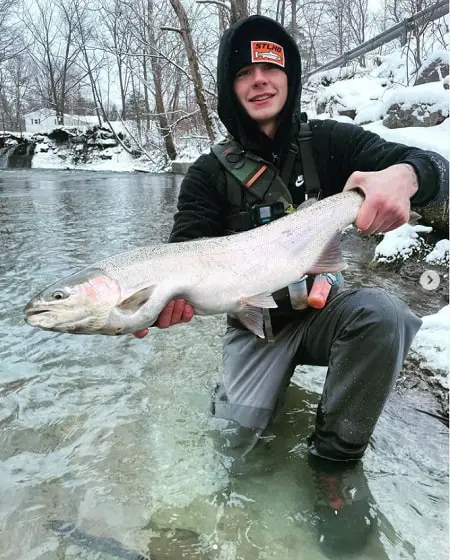
Although challenging, winter fishing for steelhead in the Pennsylvania tributaries offers some of the best steelhead fishing of the year because many of the biggest steelhead move into the rivers in late fall.
But most anglers stop fishing when the weather gets too cold. Partly because some anglers just don’t like the cold, but more often, it’s because they find it difficult to catch steelhead at this time of year.
The problem is that they keep using the same tactics that worked for them in the fall when the water was 20 degrees warmer, and these tactics are often ineffective.
Pennsylvania Steelhead Fishing Through The Winter Months
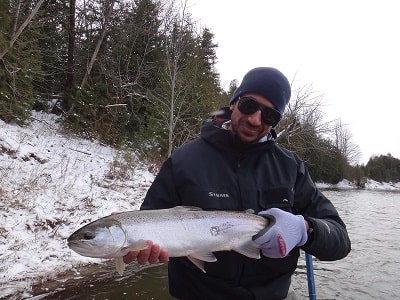
Winter steelhead fishing begins in mid-December and continues through to March with water temperatures dropping under 40°F.
I tell clients that when I start to see ice forming at the edge of the river, it’s winter steelhead fishing tactics. Some years, this might start in late November.
As this happens, the steelhead becomes inactive and gradually transitions into slow and deep waters. You may still find some late-movers in the faster runs especially if there was a recent rain, but this is not the norm.
Even though the river is ice cold, anglers can still be lucky to experience a steelhead bite on lures and swung flies.
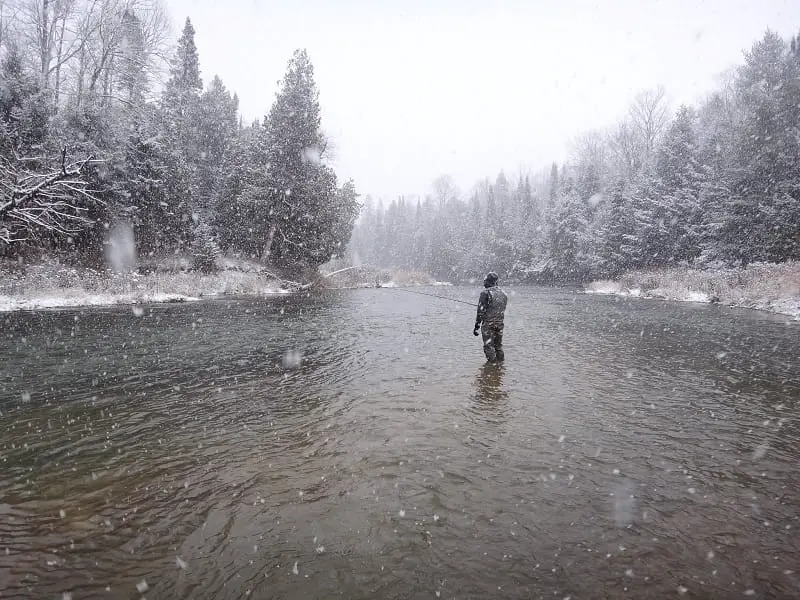
There’s a further drop in temperatures to between 34-38° which is usually in January and early February, and steelhead activity becomes dramatically slow and feeding windows are reduced.
At this point, many of the Pennsylvania rivers will be frozen solid, and even in areas with open water, it will be very difficult to get the steelhead to bite on any form of presentation.
There are often mild periods and thaws at this time and the rivers might open for a few days or more. This is when I pay particular attention to the noon time bite and try to fish on full sun days, and milder days, and also focus all my efforts on the slowest, deepest pools.
Adapting To Winter Steelhead
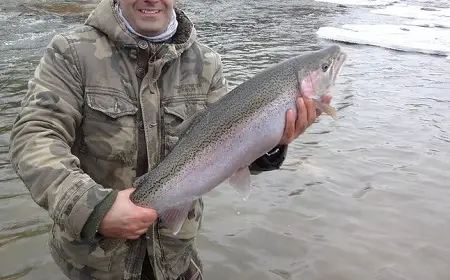
In winter, the steelhead feeding, holding, and movement patterns are much different.
You need to change when the steelhead change; because if you adapt, you can keep catching them.
Water Temps
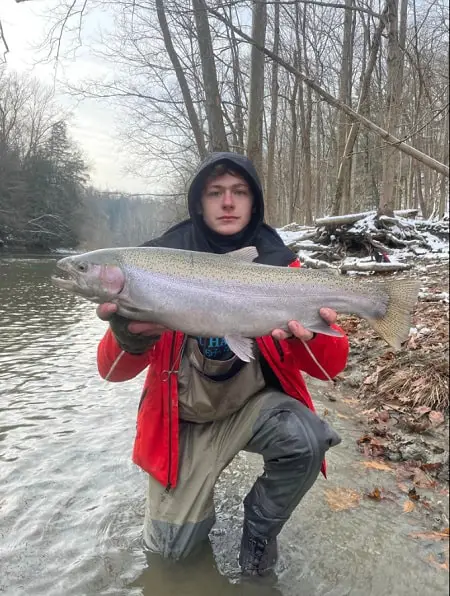
Water temperatures are coldest during the night, and nights are longer at this time of the year so the temps can drop quickly and they can drop a lot, and since steelhead are cold-blooded, this cold water drop shuts them down.
Guys that fish early in the mornings after the temperatures dropped all night will struggle because this is when the water is coldest.
I know from experience that dropping water temps often result in poor fishing, and rising water temps in winter can result in good fishing.
This is why the steelhead will get more active on warmer sunny days, when the water is warmest between 11 am and 3 pm. Anglers that fish during this time will do much better than anglers fishing early morning or just before dark.
Winter Holding Water
Where the steelhead are earlier in the fall is not where they will be holding in the winter.
When the water is icy cold, the steelhead will be in the deepest part of the bigger pools or at the tail-out of pools where the water is slower. They rest and reserve energy in these spots. It will be rare to find steelhead in smaller shallower pools, rapids, or pocket water. Fish deep, and fish slow.
Fish Smaller Baits For More Winter Steelhead
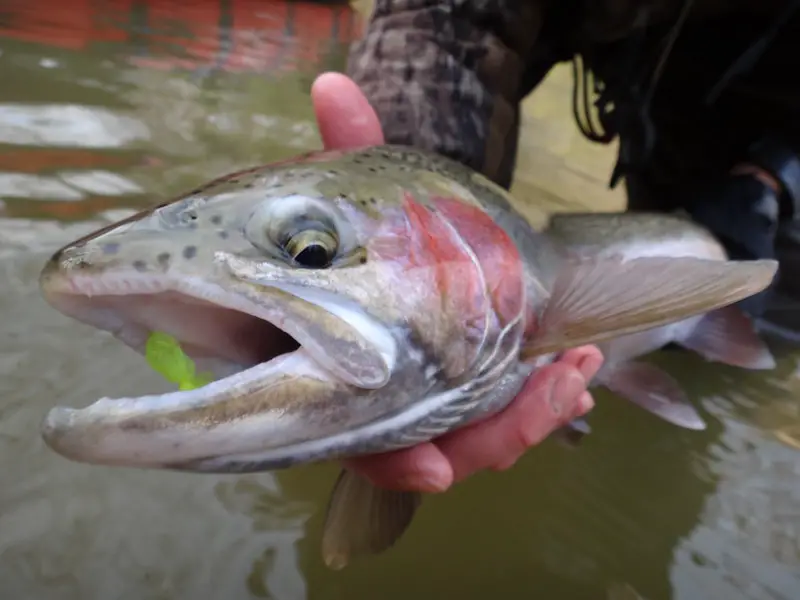
It is true that steelhead are lethargic, inactive, and less apt to bite, particularly during extreme cold water conditions, however, fishing can still be good throughout the winter if you show them baits that trigger them to feed.
Anglers need to adapt and fish smaller baits and fish them slower because steelhead won’t be as aggressive and won’t chase a bait or lure as readily as they would in early fall or late spring.
My game plan in winter is small, natural baits, fish slowly, and be consistent and persistent. You may need to make lots of casts and drifts in the same area before they grab your bait, and you may need to offer them a bunch of different baits to figure out what they want.
This is when a single egg, small bead, or small nymph will often catch ten times more steelhead than a big bright spawn bag.
Pro Tip: My clients and I have experienced some of the best steelhead fishing during the winter season, but as a guide, I will rotate through bait size, bait colors, and bait types, and I will do this over and over until I find something they want.
Temperature Is Key To Good Steelhead Fishing
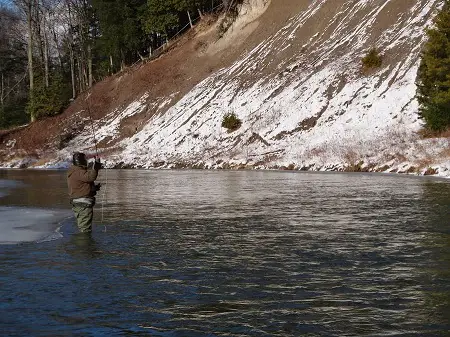
Dropping water temps suck, rising temps are good, stable temps are a maybe.
If you remember this, winter steelhead fishing might get more manageable for you.
Since I guide in the winter months and have been fishing for steelhead during the winter for over 36 years, I think I’ve figured out water temps.
I’ve fished in slush and even stood in the river dodging ice chunks of ice so big they would move a car.
Although the typical and prevalent temperatures during winter are icy and plunging, there is a window of opportunity where the water temps are stable or stepped up a few degrees which is when steelhead activity will increase.
This window comes with the rising sun, usually from the late hours of the morning through to the early hours of noon, that is, between 11 am and 2 pm. During these times (as steelhead adapts to this temperature change), steelhead return to their active feeding. But there is a but to this…
Sunny days with air temps just above or just below freezing are often best. These periods are usually the peak times for winter fishing Pennsylvania steelhead.
Best Methods for Winter Fishing Pennsylvania Steelhead
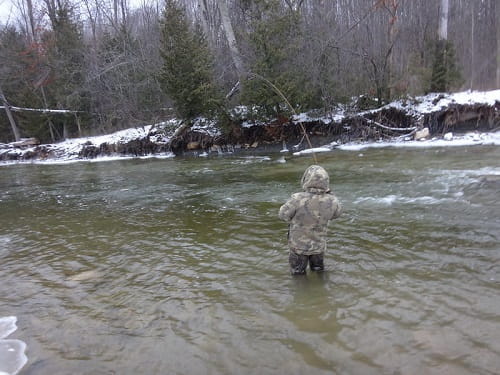
Anglers can catch winter steelhead in a variety of ways, with some methods being more effective than others depending on the conditions of the river.
The right methods can be the difference between a successful or a disappointing winter PA steelhead fishing day.
Float Fishing For Pennsylvania Steelhead
Float fishing is a popular and probably the most effective method to use when winter fishing for steelhead in PA.
If done correctly, float fishing allows you to slow your presentation down and thus effectively targeting both the aggressive and neutral steelhead. Slow and deep is the key to catching more steelhead.
Successful float fishing at any time of the year, but more so in the winter requires four fundamentals such as covering the water well, using the right setup, speed control, and depth control. I discuss this on my page Float Fishing For Steelhead – A River Guides Advice.
Fly Fishing For Pennsylvania Steelhead
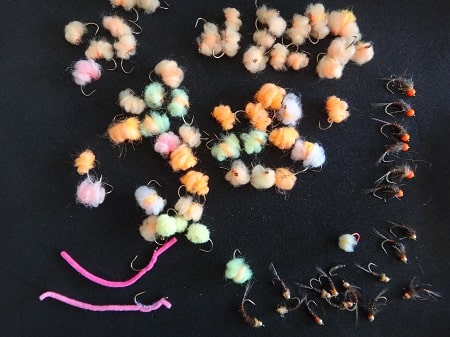
Fly fishing for winter steelhead can be challenging for a whole lot of anglers but it can also be one of the more effective and rewarding ways to land some big winter steelhead.
In the winter, small nymphs and egg patterns can be deadly on steelhead, especially if they are still being pressured with lots of spawn sacs going by them all day.
Check out my favorite choice of flies on my page, 21 Best Flies For Pennsylvania Steelhead.
Presentation and is one of the major things I teach my clients and students on any guide trip and if you present your fly properly you will catch more steelhead in the winter. Fly fishing using indicators or tight line methods are often best. Check out my page Fly Fishing For PA Steelhead.
Best Baits and Flies for Winter Fishing Pennsylvania Steelhead
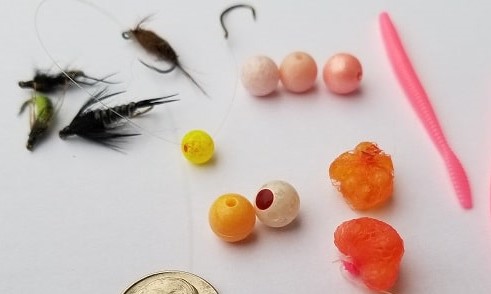
There are a number of baits that can be used for winter fishing Pennsylvania steelhead.
Knowing the right bait to use, whether in terms of size or color can go a long way to make a significant difference.
Personally, I like to downsize or change my bait a lot. I have observed that steelhead often ignore big intrusive baits and are likely to take on smaller baits.
The best baits for winter steelhead in PA are:
- Single Salmon Eggs – white, light yellow, light pink.
- Spawn/Roe – Tiny Spawn bags of 3 salmon eggs, or five steelhead eggs – Blue, white, light yellow, light pink
- Beads – 6mm and 8mm, plastic, glass, or soft beads are very good. White, light yellow, light pink
- Plastic Worms – Plastic steelhead worms worm very well for me all year and even in the winter. Three to 4-inch worms are best. Pink and red are my go-to colors.
If you are interested in knowing all the baits that I like to use check them out on my page Best Steelhead Baits.
Dressing for Winter Fishing Pennsylvania Steelhead
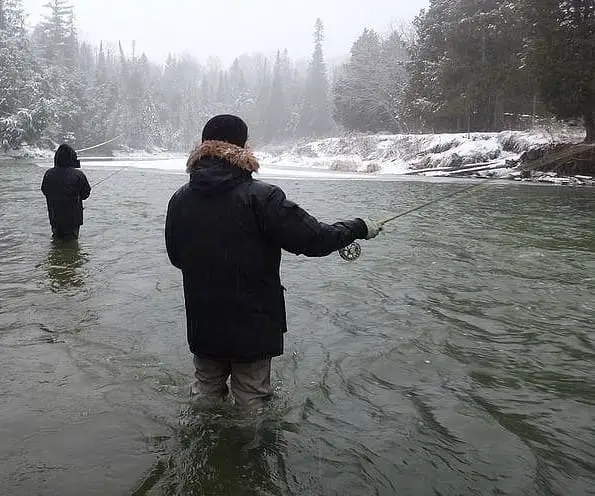
Preparing for winter steelhead fishing in Pennsylvania involves more than having the correct gear, such as rods, line, and even flies.
It also largely depends on having the correct outerwear and clothes.
This is often the toughest part of the whole experience for many anglers, but river guides are standing in icy water and air temps all day every day, and they do so easily because they know how to dress properly.
Boots – The river banks are likely to be icy and slippery so proper footwear with good traction. Cleats are almost a must-have. Even slip-on cleats are a good idea.
Waders: Did you know some waders are colder on your feet than others? Insulated bootfoot waders are the best, but if you don’t have them, I have some tips to keep your feet warm on my page Fishing In The Winter – Stay Warm With These 10 Tips.
Gloves: Good fishing gloves are a must, and I always have at lease two pairs incase one gets wet.
Core and Body: To generally keep warm when fishing in this season, make sure you use the proper base layers. A warm core can actually keep your hands and feet warmer.
Jackets: Most wading jackets are not insulated but they are good for holding your gear and keeping you dry. Many anglers will wear a puff jacket instead of a wading jacket in the winter.
Icy Guides: I recommend coating the guides with Stanley ice off-paste before any winter fishing outing to help with reducing the icing.
Tight Lines,
Graham
